- Joined
- Mar 26, 2006
- Messages
- 15,298
@Matata, in the Daily Happy Hour thread you asked if I had any info on your beautiful glasses:
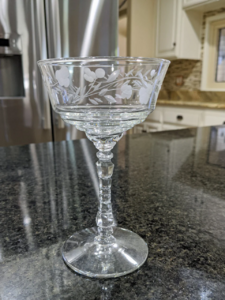
I had some ideas about them at the time, but I've kept an eye out hoping that I would come across better information -- and tonight I did! They were made by Libbey Rock Sharpe Glass Works.
Here is info from Replacements, Ltd.:
If you had to pick two words to describe Libbey Glass Company's offerings over the years, "diverse" and "prolific" would certainly apply. The company has delivered such a wide array of goods: cut glass, art glass, blown glass, inexpensive hand and machine ware, pattern glass, and glassware for the hotel and restaurant trades. The list goes on!
Of course, many of these products were partly a reflection of longevity - the firm dates back to 1818 when it was originally founded as The New England Glass Company of East Cambridge, Massachusetts. The Libbey name became associated with the company through changes of ownership; William L. Libbey and his son, Edward D. Libbey, purchased New England Glass in the late 1870's, moving it to Toledo, Ohio in 1888. The name of the company was changed to The Libbey Glass Company in 1892.
For over a 100 years, from about 1820 to 1920, cut glass was the principal product of New England Glass/The Libbey Glass Company. In fact, Libbey was one of the world's largest producers of cut glass during the early part of this century, employing over 200 full-time engravers in 1915, leaving behind a tremendous legacy of cut glass tableware, serving pieces, and items for the home, such as vases and lamps.
These products were fashioned from expensive lead glass and engraving was done using the demanding copper-wheel technique, which is the finest and most detailed kind of engraving. Many patterns and designs were made in sets of various sizes. Today, it is common to see examples of Libbey's brilliant cut glass products on display at museums.
In the 1920's, when the popularity of cut glass began to wane, Libbey's production shifted to inexpensive hand and machine ware. "Safedge Glassware" featuring a chip-resistant rim was introduced in 1924. The Libbey Company guaranteed customers "a new glass if the rim ever chips." This glassware helped Libbey become a top supplier of wares to restaurants and hotels.
Later, there were various attempts by Libbey to revive fine glassware. For instance, The Libbey-Nash line, which was introduced in the early 30's, featured 80 patterns of hand-crafted stemware, of Steuben-like quality. The series was designed by A. Douglas Nash, a former executive with Tiffany's in Corona, New York. The luxury line was priced from $15 to $2,500 a dozen.
In 1940, when Libbey Glass was an operating division of Owens-Illinois, Modern American was introduced. This line consisted of bubble-thin table services and decorative pieces in clear crystal and colors. It was the last hand-crafted glass made by Libbey. To publicize this series, Hollywood motion picture studios were supplied with full sets of the glassware. The 1940 movie "No Time for Comedy" with Jimmy Stewart has a formal table adorned with crystal in the Embassy pattern. Modern American was not made after World War II.
In the late 50's, Libbey's 1818 Line of machine made stemware was made to compete with hand-crafted patterns. 1818 Stemware was named for the year the company was founded. It consisted of automatically blown stems with the Safedge rims ground off. The bowls were cut with mitre-type designs. It was only offered for a short time in leading retail stores in major cities.
Also, in 1948, in a bid to further enhance Libbey's glass decorating capabilities, Owens-Illinois acquired the Cataract-Sharpe Manufacturing Company of Buffalo, New York, and made it a subsidiary known as Sharpe, Inc. The Cataract Company was a high quality cutting operation that decorated fine handmade stemware, tumblers and accessory pieces supplied by other firms.
For many years, Cataract-Sharpe had purchased blanks from the Libbey Glass Division of Owens-Illinois and decorated the crystal at its factory in Buffalo. Bryce Brothers Crystal and A. H. Heisey were other big suppliers of crystal for Cataract Sharpe in the 30's and 40's. The company made no glass itself.
The Cataract Company was originally formed in 1914 by Alfred H. Sharpe, who had been a manager at Fostoria Glass Company. Until 1920, the firm was known as Cataract Glass Company. Cataract-Sharpe cut many intricate, deep-cut crystal patterns. Many of the designs were ornately done and brilliantly polished. A fern-like leaf design was a very typical design for Sharpe and it appears in a variety of their cut patterns. It is important to note that the company's specific stem designs were not matched with any particular cuttings.
In the 30's and 40's, the company widely promoted its Rock Sharpe Crystal products in many of the major women's magazines. According to advertisements, the crystal was described as featuring "smart modern or rich period motifs." The stemware was sold at virtually every major department store in the country.
"Rock Sharpe was some of the best-selling stemware in America during that period," recalls Joanne Miller of Buffalo, New York, whose father, Andrew Cunningham, was vice-president of sales for Cataract-Sharpe in the 20's and 30's. "My dad also designed many of the Rock Sharpe patterns. He even designed a pattern for me." Miller says as far as she can remember, the company only decorated clear, not colored crystal.
The Cataract-Sharpe Company had extensive equipment for decorating and highly skilled cutters who employed advanced cutting and polishing methods. Until World War II, lead glass was used for Cataract-Sharpe's highest grade cut crystal glassware. The wartime shortage of lead glass temporarily intervened with Cataract's use of this product. All glass firms were required to cut back their production of glassware that was nonessential to the war effort.
After Owens-Illinois bought Cataract-Sharpe, Alfred Sharpe continued on as the President of Sharpe, Inc. R. W. Rogers, formerly a sales manager of the Libbey Glass Division of O-I, became vice-president and general manager.
In the late 40's and 50's, Sharpe, Inc. continued to produce patterns that had previously been made at Cataract-Sharpe. In addition, several new Sharpe patterns were introduced, including "Empire Wreath", "Spear and Ring", "Lattice" and "Bramble." Eventually, however, Owens-Illinois discontinued altogether the Sharpe cut crystal line.
The Libbey Glass Division is still in operation in Toledo, Ohio and has a modern plant in City of Industry, California that was built in 1962. The company is one of the world's largest suppliers of automatically-produced table glassware.
Source: Page, B.; Frederiksen, D.; A Collection of American Crystal A stemware Identification Guide for Glastonbury/Lotus, Libbey/Rock Sharpe & Hawkes; Greensboro, NC: Page/Frederiksen Publications; 1995

I had some ideas about them at the time, but I've kept an eye out hoping that I would come across better information -- and tonight I did! They were made by Libbey Rock Sharpe Glass Works.
Here is info from Replacements, Ltd.:
If you had to pick two words to describe Libbey Glass Company's offerings over the years, "diverse" and "prolific" would certainly apply. The company has delivered such a wide array of goods: cut glass, art glass, blown glass, inexpensive hand and machine ware, pattern glass, and glassware for the hotel and restaurant trades. The list goes on!
Of course, many of these products were partly a reflection of longevity - the firm dates back to 1818 when it was originally founded as The New England Glass Company of East Cambridge, Massachusetts. The Libbey name became associated with the company through changes of ownership; William L. Libbey and his son, Edward D. Libbey, purchased New England Glass in the late 1870's, moving it to Toledo, Ohio in 1888. The name of the company was changed to The Libbey Glass Company in 1892.
For over a 100 years, from about 1820 to 1920, cut glass was the principal product of New England Glass/The Libbey Glass Company. In fact, Libbey was one of the world's largest producers of cut glass during the early part of this century, employing over 200 full-time engravers in 1915, leaving behind a tremendous legacy of cut glass tableware, serving pieces, and items for the home, such as vases and lamps.
These products were fashioned from expensive lead glass and engraving was done using the demanding copper-wheel technique, which is the finest and most detailed kind of engraving. Many patterns and designs were made in sets of various sizes. Today, it is common to see examples of Libbey's brilliant cut glass products on display at museums.
In the 1920's, when the popularity of cut glass began to wane, Libbey's production shifted to inexpensive hand and machine ware. "Safedge Glassware" featuring a chip-resistant rim was introduced in 1924. The Libbey Company guaranteed customers "a new glass if the rim ever chips." This glassware helped Libbey become a top supplier of wares to restaurants and hotels.
Later, there were various attempts by Libbey to revive fine glassware. For instance, The Libbey-Nash line, which was introduced in the early 30's, featured 80 patterns of hand-crafted stemware, of Steuben-like quality. The series was designed by A. Douglas Nash, a former executive with Tiffany's in Corona, New York. The luxury line was priced from $15 to $2,500 a dozen.
In 1940, when Libbey Glass was an operating division of Owens-Illinois, Modern American was introduced. This line consisted of bubble-thin table services and decorative pieces in clear crystal and colors. It was the last hand-crafted glass made by Libbey. To publicize this series, Hollywood motion picture studios were supplied with full sets of the glassware. The 1940 movie "No Time for Comedy" with Jimmy Stewart has a formal table adorned with crystal in the Embassy pattern. Modern American was not made after World War II.
In the late 50's, Libbey's 1818 Line of machine made stemware was made to compete with hand-crafted patterns. 1818 Stemware was named for the year the company was founded. It consisted of automatically blown stems with the Safedge rims ground off. The bowls were cut with mitre-type designs. It was only offered for a short time in leading retail stores in major cities.
Also, in 1948, in a bid to further enhance Libbey's glass decorating capabilities, Owens-Illinois acquired the Cataract-Sharpe Manufacturing Company of Buffalo, New York, and made it a subsidiary known as Sharpe, Inc. The Cataract Company was a high quality cutting operation that decorated fine handmade stemware, tumblers and accessory pieces supplied by other firms.
For many years, Cataract-Sharpe had purchased blanks from the Libbey Glass Division of Owens-Illinois and decorated the crystal at its factory in Buffalo. Bryce Brothers Crystal and A. H. Heisey were other big suppliers of crystal for Cataract Sharpe in the 30's and 40's. The company made no glass itself.
The Cataract Company was originally formed in 1914 by Alfred H. Sharpe, who had been a manager at Fostoria Glass Company. Until 1920, the firm was known as Cataract Glass Company. Cataract-Sharpe cut many intricate, deep-cut crystal patterns. Many of the designs were ornately done and brilliantly polished. A fern-like leaf design was a very typical design for Sharpe and it appears in a variety of their cut patterns. It is important to note that the company's specific stem designs were not matched with any particular cuttings.
In the 30's and 40's, the company widely promoted its Rock Sharpe Crystal products in many of the major women's magazines. According to advertisements, the crystal was described as featuring "smart modern or rich period motifs." The stemware was sold at virtually every major department store in the country.
"Rock Sharpe was some of the best-selling stemware in America during that period," recalls Joanne Miller of Buffalo, New York, whose father, Andrew Cunningham, was vice-president of sales for Cataract-Sharpe in the 20's and 30's. "My dad also designed many of the Rock Sharpe patterns. He even designed a pattern for me." Miller says as far as she can remember, the company only decorated clear, not colored crystal.
The Cataract-Sharpe Company had extensive equipment for decorating and highly skilled cutters who employed advanced cutting and polishing methods. Until World War II, lead glass was used for Cataract-Sharpe's highest grade cut crystal glassware. The wartime shortage of lead glass temporarily intervened with Cataract's use of this product. All glass firms were required to cut back their production of glassware that was nonessential to the war effort.
After Owens-Illinois bought Cataract-Sharpe, Alfred Sharpe continued on as the President of Sharpe, Inc. R. W. Rogers, formerly a sales manager of the Libbey Glass Division of O-I, became vice-president and general manager.
In the late 40's and 50's, Sharpe, Inc. continued to produce patterns that had previously been made at Cataract-Sharpe. In addition, several new Sharpe patterns were introduced, including "Empire Wreath", "Spear and Ring", "Lattice" and "Bramble." Eventually, however, Owens-Illinois discontinued altogether the Sharpe cut crystal line.
The Libbey Glass Division is still in operation in Toledo, Ohio and has a modern plant in City of Industry, California that was built in 1962. The company is one of the world's largest suppliers of automatically-produced table glassware.
Source: Page, B.; Frederiksen, D.; A Collection of American Crystal A stemware Identification Guide for Glastonbury/Lotus, Libbey/Rock Sharpe & Hawkes; Greensboro, NC: Page/Frederiksen Publications; 1995

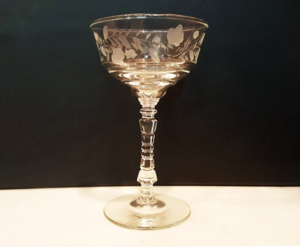
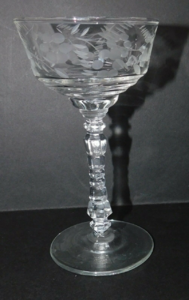

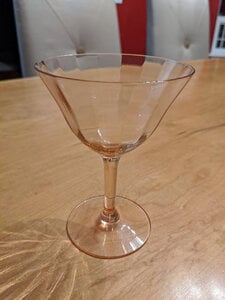
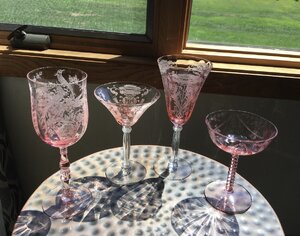


300x240.png)